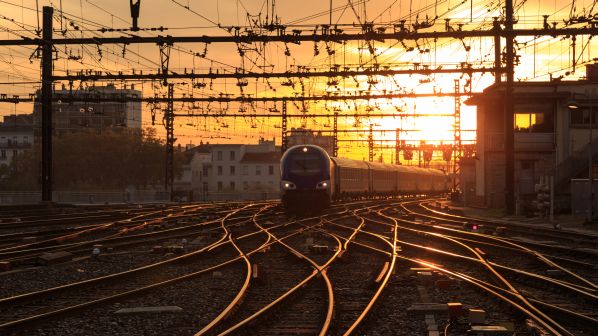THE threat of catastrophic climate change is forcing an urgent re-evaluation of how industrial energy users source their power, and how efficiently they use it. Since last year, all traction energy on the Dutch network has been drawn from renewable sources and other countries are looking to follow this lead. With traction power accounting for more than 80% of railway energy consumption, railways are also exploring ways of increasing energy efficiency both to minimise their environmental impact and reduce costs.
The modernisation of electrification systems is being pursued in many countries as a means of reducing power losses in the network and taking advantage of the regenerative capabilities of modern trains. While the trend in Europe has long been towards standardisation on ac electrification, upgrading of legacy dc systems is now seen as an alternative way forward in some countries. In the Netherlands, where switching the 1.5kV dc system to 25kV ac was given serious consideration in the 1990s, the Ministry of Infrastructure and infrastructure manager ProRail are currently considering converting the network to 3kV dc.
The Netherlands has a 2100km electrified network supplied by 243 substations (2.5-12MVA) located at 3-21km intervals. Annual traction energy consumption currently totals around 1400GWh.
In 2010 ProRail began to re-evaluate the proposed ac migration and found it could build a stronger business case around 3kV dc. “There was a high migration cost for 25kV ac, so it wasn’t beneficial,” Mr Fedor Ten Harve, energy systems specialist for ProRail, told delegates at the UIC’s Workshop on Energy Efficiency in Rotterdam on February 11. “3kV dc is interesting and we’ve really investigated the benefits and costs. Power consumption increases a little, but transmission losses decrease a lot.”
ProRail’s analysis found that switching to 3kV would allow 100% of regenerative braking energy to be returned to the grid, compared with 50% for the current 1.5kV dc system. This means that while the power consumption of the train is greater, substation power consumption falls by a much larger margin. With more power available to the train, acceleration would improve by 7-14 seconds per timetabled stop, generating significant benefits on a densely-used network facing severe capacity constraints as traffic continues to increase.
Overall, ProRail estimates it will need to buy 20% less power from the grid with a forecast annual energy saving of 290GWh.
The migration would be implemented in two phases, with the construction of new substations followed by a switchover which would take place on a region-by-region basis. A government decision on whether to go ahead with the conversion is expected later this year.
France is also evaluating the future of its 6000km 1.5kV dc network, where electrification systems are largely life-expired or approaching end-of-life. The government has ruled out conversion of dc lines to the 25kV 50Hz ac system used in northern France, and infrastructure manager SNCF Network is therefore studying a programme of migration to a Medium Voltage (MVDC) system.
The switch to MVDC would blend the advantage of the existing electrification systems, including power sharing between substations, three-phase power supplies from the public grid, a simple onboard power converter on the locomotive, and light overhead line with no inductive voltage drop. SNCF Network says power electronics technology has reached a state of maturity where 9kV dc is a viable option for rail electrification. High-voltage dc power converters, solid state dc circuit breakers, the availability of medium-voltage drives for industrial motors and the development of Silicon Carbide semi-conductors all support a shift to MVDC.
In the first phase of the proposed migration strategy, 9kV transformer-rectifier groups and feed wires will be added to the existing 1.5kV catenary. Intermediate 1.5kV transformer-rectifier groups will be replaced with dc-dc Power Electronics Transformers (PETs). Under this so-called “three wire” system trains will continue to be fed via the existing twin 1.5kV contact lines. In the final stage, the overhead line will be supplied by 9kV substations located at 40-100km intervals, compared with 10-15km for the current 1.5kV substations, significantly reducing the number of substations on the network. The dc-dc PETs and/or MVDC converters will be embedded in the traction units.
A case study for conversion has been carried out on the 100km Lamothe - St Paul section of the Bordeaux - Hendaye line in southwest France. Here, the number of substations would be cut from six to two while the average overhead line cross section per track would be reduced from 850mm2 to 266mm2. Total energy supplied by the substations would fall by 2.5MWh per half day, with increased overhead line efficiency and reduced power losses.
SNCF estimates that the 70% reduction in the cross section of the overhead line will generate a saving of around €20m in copper wiring costs per 100km of track. The reduction in the number of substations means the electrification system has around 60% less installed power. The efficiency of the system increases by around 6% and the switch to 9kV is forecast to generate an energy saving of 2GWh a year per 100km of track, equivalent to around €150,000 annually.
Superconducting cables are another traction innovation under evaluation in France. Superconducting materials exhibit zero resistance when cooled below a critical temperature, offering potentially significant energy savings. The first trials with superconducting cables on a passenger railway were carried out on Japan’s 1.5kV dc Sunzu Line in 2015. Superconducting wire was used to link ac-dc transformers at a substation to the traction supply system, and the cable was cooled to -19oC.
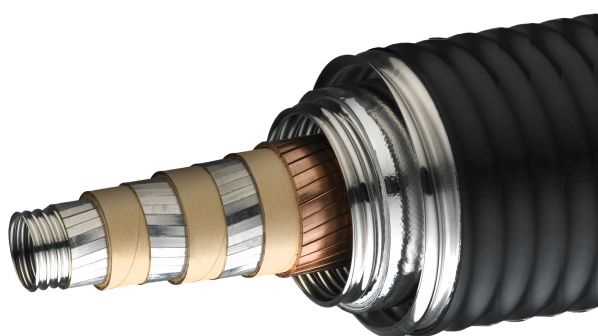
SNCF Network and cable manufacturer Nexans are trialling the use of bipolar superconducting cables for 1750V dc with current ranging from 5 to 15kA. The cable linking the traction return with the overhead catenary system is cooled with liquid nitrogen at 6-9 Bar. The increase in liquid temperature along the length of the cable is offset by a heat exchanger. A cable with an external diameter of 150mm and a core diameter of 53.2mm can transmit 9MW at a nominal current of 5kA. With a 58mm core diameter, 26.5MW can be transmitted at 15kA.
SNCF Network and Nexans say the footprint of a 15kA cable system with return current can be reduced by a factor of 20, with the superconducting cable system requiring just a 20x20cm footprint, significantly reducing the use of raw materials such as copper. Operational costs are reduced by a factor of three for a 2.5km-long 15kA cable. With a smaller cable diameter, installation costs are reduced and there is no heat generation or electromagnetic emissions.
Autotransformers
Norwegian infrastructure manager Bane Nor is implementing a programme of measures to improve energy efficiency and reduce costs across its 2459km electrified network, which is equipped with a 15kV 16 2/3Hz traction power system. Bane Nor purchases 772GWh of electricity annually, supplied entirely from hydro-electric power stations.
According to Mr Dyre Martin Gulbrandsen, energy trading manager for Bane Nor, system losses have been reduced from 15% in 2007 to 11% in 2017, thanks largely to improvements in autotransformer technology. This has enabled an increase in supply voltages from 15kV to 30kV and reduced transmission losses in the contact line by 56%, while enabling an increase in the distance between converter stations from 80 to 120km.
At present around 75% of converter stations on the Norwegian network use ageing rotary converter technology, which suffer from high power losses. Bane Nor is implementing a programme of measures including automatic operation and start-stop functionality with the aim of reducing converter losses by 8% or 10GWh.
The increasing efficiency of electric trains is also playing a significant role in reducing energy demand. Between 2007 and 2017 the volume of regenerative braking energy generated by electric trains on the Norwegian main line network increased by 154%. Regenerative energy not consumed in the traction power supply is sold back to the grid at the market price. “We have rethought our link to the energy market,” Gulbrandsen says. “Once we were considered an energy consumer. Now we are a producer.”
On the Norwegian section of the Kiruna - Narvik line, loaded heavy-haul iron-ore trains running down grade from the Swedish border to the port of Narvik return regenerated braking energy to the grid for more than 15 hours a day.
However, exploiting the performance of powerful new trains can generate issues as well as benefits. “Power is a challenge, and for the IM, power is a cost,” Gulbrandsen says. “This means we have to invest in new converter stations. We have invested in mobile converter stations, but these all ended up in the Oslo area because the power demand is so great. It’s also a challenge because we only need very high capacity for a small amount of time each day.”
Trackside energy storage systems (ESSs) are another option for improving the energy efficiency of operations on electrified lines, although such solutions face a number of challenges in the railway environment. According to Mr Akos Labady, senior field application engineer for Eaton, a trackside ESS needs to be capable of absorbing large bursts of energy, potentially amounting to several megawatts, in a timeframe of 30-60 seconds. System architecture also needs to reflect the fact that braking power varies between train types and the charge and discharge sequence is unpredictable, with significant variation in power demand between peak and off-peak periods.
An optimised ESS design is therefore needed to maximise the return on investment. There are three options for lineside energy storage - supercapacitors, lithium-ion batteries and flywheels. Labady says the energy regeneration cost per return is similar for supercapacitor and Li-Ion technology. Supercapacitors are more cost effective if the regeneration frequency is higher than one in five minutes and they are better suited to outdoor applications as they offer a high degree of efficiency in extreme temperatures. Supercapacitors are also maintenance-free and have a long life, making them suitable for locations where access is difficult. Li-Ion batteries are more cost effective in scenarios where the regeneration frequency is lower than one in five minutes and if the stored energy is to be used for powering catenary for long periods (up to 30 minutes) if the external power supply fails.
Labady says hybrid battery-supercapacitor ESS solutions can offer the best of both worlds in rapidly-fluctuating regeneration cycles, with the supercapacitor handling peak current charge and discharge. This results in longer battery life, less thermal stress on the battery, and improved efficiency.
High in the French Alps, SNCF Network has been evaluating a supercapacitor ESS at Le Tines on the metre-gauge St Gervais - Vallorcine line, which is equipped with 750V dc third rail electrification. The aim of the project was to find a quick and economical means of improving the quality of the dc power supply. SNCF Network worked in partnership with French firm Centum Adetel, which supplied its NeoGreen ESS for the project. Installation took place in June 2015 and validation tests were completed in 2017.
The 330kW unit is 30% smaller than a standard substation and can supply up to 1kWh of usable energy. SNCF Network says the ESS is maintenance free, and the only interventions so far have been an annual visit to remove dust and measure dc resistance.
Alternatives to diesel
Beyond the electrified network, hydrogen fuel cell and battery propulsion are increasingly seen as viable alternatives to diesel operation and a means of reducing harmful particulate emissions. Most of the major rolling stock suppliers are working to commercialise main line hydrogen and battery-electric trains, in many cases with the support of academic institutions and government-funded research programmes.
Battery propulsion will enable the operation of electric trains on non-electrified lines and reduce diesel mileage under the wires. Batteries will generally be charged while the train is in motion, although static charging at stations could also be considered to extend the range of battery trains on non-electrified lines. Last month British rolling stock manufacturer Vivarail demonstrated a fast charging system, which can fully charge the battery propulsion system on its class 230 multiple unit in seven minutes, providing a range of up to 100km.
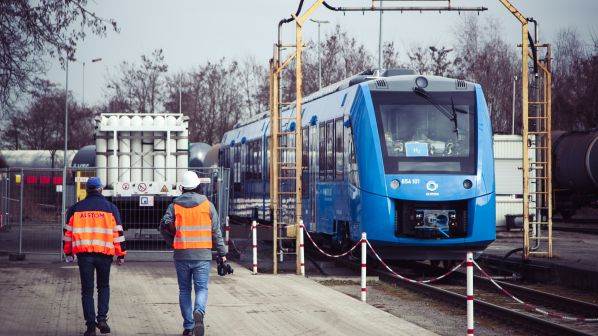
The fast charging system comprises short sections of third and fourth rail, with the train drawing power via shoegear, which connects to the rail automatically. Due to the high currents required, Vivarail has used a carbon ceramic shoe able to withstand the heat generated in the process, as a longer charge time would make operational running unfeasible. The system is only live when the train is in situ.
The fast charge system is equipped with a battery bank comprising packaged second-use batteries connected to the main grid to continuously trickle charge. The charge stored in the battery bank is then “dumped” into the train.
The 12-month project was supported by a grant from the Accelerating Innovation in Rail 4 competition, funded by Britain’s Department for Transport (DfT) and delivered by InnovateUK.
Hydrogen is rapidly gaining ground as an alternative to diesel. In November 2017, Lower Saxony Transport Authority (LNVG) awarded Alstom and gas supplier Linde Group a contract to supply 14 iLint fuel cell multiple units for services from Cuxhaven to Bremerhaven, Bremervörde, and Buxtehude in northwest Germany. A prototype iLint entered service in September 2018 and the series trains will be introduced in December 2021, replacing DMUs operated by Elbe-Weser Transport Company (EVB).
The contract includes 30 years’ maintenance and fuel supply for the fleet. A €10m hydrogen refuelling facility at Bremervörde is being funded with the aid of a €8.4m grant from the German federal government’s National Innovation Programme for Hydrogen and Fuel Cell Technology. Linde is responsible for obtaining a construction permit and operating the facility. In a later phase of the project, hydrogen will be produced on-site at Bremervörde using electrolysis with a wind turbine providing power for the process.
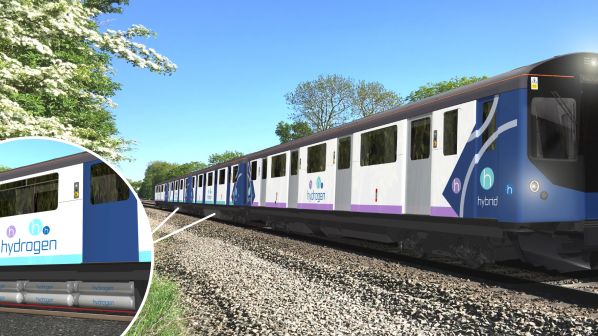
The sourcing of energy for hydrogen production is a key consideration when evaluating the potential environmental sustainability of fuel cell train deployment. “The use of renewables in hydrogen production will evolve as the total energy system evolves,” explains Professor David Hart, director of sustainable energy consultancy E4tech. “Trains are a big enough demand centre to make a difference, so it’s plausible to construct fuel production facilities for a line or a group of lines, which you can’t do so easily for bus transport where the fuel demand is lower.”
The cost of fuelling and storage facilities is another important factor in the business case for hydrogen trains. Hart says the cost can be brought down if infrastructure is shared with other hydrogen consumers, and this is likely to be an increasingly viable option for rail operations in the future. Global hydrogen demand is forecast to increase from 8 Exajoules (EJ) in 2015 to 14 EJ in 2030 and 78 EJ in 2050, with transport accounting for much of the projected increase. “There are useful effects when you think about how rail fits with the energy system, for example the colocation of facilities with a hydrogen pipeline or bus fuelling facilities,” Hart says. “A lot of easy wins can be had with a coordinated approach.”
Networks of hydrogen production, distribution and storage infrastructure already exists in areas such as Rotterdam, the Ruhr region of Germany and northeastern France, where there are clusters of industrial users, and Hart says this may help to provide a foundation for rail deployments.
One example of this can be found on the Dutch coast close to the border with Belgium. An evaluation of different traction options was carried out to support a proposal for the reintroduction of passenger services on the freight-only line between Gent, Belgium, and the Dutch port of Terneuzen. This found hydrogen was the most suitable technology, in part due to the presence of an existing large-scale hydrogen network in the area.
The evaluation found there would be no need for liquid hydrogen transportation and storage and no need for costly cryogenic equipment. The fuelling station could be connected to a high-pressure hydrogen pipeline, generating savings in infrastructure costs for the rail project.
Improving the energy efficiency of rail depends on the ability of infrastructure managers and train operators to identify the opportunities for savings, working together and bringing in expertise from other sectors where necessary to make gains. While there is no single “silver bullet” to achieving efficient traction, innovation programmes at a national level, and international initiatives such as Shift2Rail, show the way forward, helping to build the foundations for a more sustainable railway.
Case study: can Britain phase out diesel-only trains by 2040?
In February 2018, Britain’s then rail minister, Mr Jo Johnson, challenged the industry to phase out the operation of diesel-only trains on the main line network by 2040. A report by the Rail Industry Decarbonisation Taskforce (RIDT) and the Rail Safety and Standards Board (RSSB), which was published in January, indicated that this aspiration is achievable, albeit with the caveat that there is no “silver bullet” solution to replace diesel traction.
Alternatives must be benchmarked against electrification, lifecycle costs and carbon impacts to ensure perverse outcomes are not preferred, the report warns. These benchmarks will also need to be updated periodically as alternative traction technologies develop.
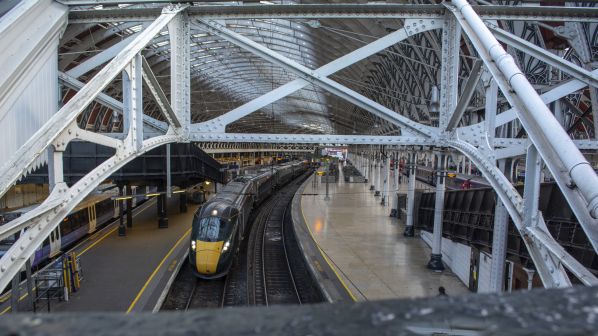
At present only 42% of the 15,811km network is electrified and according to Network Rail data this will only increase to 48% by 2039. Delays and cost overruns, notably the almost three-fold escalation in the cost of the Great Western Electrification Programme (GWEP) have brought the economics of electrification under political scrutiny, leading to the cancellation or descoping of some projects.
Traction energy accounts for 63% of greenhouse gas emissions from Britain’s railways. During 2016-2017, electric passenger trains consumed 3524 million kWh of electricity and 501 million litres of diesel, generating 2.96 million tonnes of CO2. Figures from the Office of Rail and Road show passenger rail emissions fell significantly in the decade to 2016 due to the introduction of new rolling stock and improvements in rail operations.
However, pure electric vehicles now comprise more than 72% of the national fleet and more than 80% of committed new vehicles. All 1030 bi-mode vehicles in operation or on order are equipped with diesel engines.
The RIDT-RSSB report says that decarbonising traction energy “could be achieved progressively through franchises or sending clear signals to the market through policy and other mechanisms.” The pace of change will depend on whether the government and the industry are able to develop clearer and more consistent policies, as well as the availability of incentives where the business case for investment does not exist.
An RSSB-commissioned research project, Options for Traction Energy Decarbonisation in Rail (T1145) found that in the short-term, a “reasonable reduction in carbon emissions” can be achieved by taking advantage of recent advances in diesel engine technology and encouraging the use of bi-mode trains. An estimated 85% of diesel engines in use on passenger trains on the British network predate any emissions regulations and the taskforce report indicates that employing “state-of-the-art fuel efficiency measures” alongside hybridisation could generate a 40% reduction in CO2 per kWh.
In the medium-term, T1145 says hydrogen fuel cells offer a more practical solution for reducing carbon emissions, although applicable standards and the restrictive British loading gauge are highlighted as obstacles to the commercial use of hydrogen trains.
T1145 found that the volume required for hydrogen storage effectively limits fuel cell trains to a maximum of 120km/h and for operation at 160km/h or more “electrification is the obvious and only practical option to decarbonise Britain’s railways.” The taskforce says its research demonstrates that no suitable alternatives to diesel or electric traction will exist for such operations before 2040. Furthermore, it is clear hydrogen and battery power will not provide a viable alternative to diesel traction for rail freight operations.
With further decarbonisation of power generation in the coming years, the report says it “makes sense” to electrify heavily-used lines where there is no credible alternative means of achieving zero or near-zero carbon emissions. This includes all routes with line speeds exceeding 120km/h and lines with significant freight flows.
“Advanced hybrid” trains could reduce carbon emissions by 40% on non-electrified lines, according to the report, with hydrogen fuel cells considered “the best option” for achieving reductions beyond this. However, the report stresses that hydrogen production would need to be based on the use of low-carbon electricity. It also warns of potential challenges arising from the need for supporting infrastructure for alternative traction, suggesting that the operational impact may exceed that of diesel.
“On its own, the rail industry is unlikely to be able to achieve a cost-effective rollout of a completely new infrastructure for providing, say, hydrogen or some form of synthesised gas fuel, as it will not be able to amortise the development costs on a large enough scale,” the report states.
Last month the Railway Industry Association (RIA) published its Electrification Cost Challenge Report, which indicates a 33-50% reduction in electrification costs is achievable. RIA suggests that cost increases in projects such as GWEP should be viewed as a one-off, the product of “an unrealistic programme of work, unpreparedness in using novel technologies resulting in poor productivity, and a ‘feast and famine’ electrification policy.”
RIA therefore recommends a 10-year rolling electrification programme “to progressively lower the long-term operating costs of the railway towards European norms and support investment in people, process and plant.” It urges the government to endorse electrification as the first choice for decarbonising rail operations, and measures to ensure future projects adopt a realistic programme and risk allocation.
